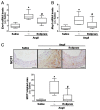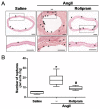Rolipram Prevents the Formation of Abdominal Aortic Aneurysm (AAA) in Mice: PDE4B as a Target in AAA
- PMID: 33809405
- PMCID: PMC8000788
- DOI: 10.3390/antiox10030460
Rolipram Prevents the Formation of Abdominal Aortic Aneurysm (AAA) in Mice: PDE4B as a Target in AAA
Abstract
Abdominal aortic aneurysm (AAA) is a common life-threatening condition characterized by exacerbated inflammation and the generation of reactive oxygen species. Pharmacological treatments to slow AAA progression or to prevent its rupture remain a challenge. Targeting phosphodiesterase 4 (PDE4) has been verified as an effective therapeutic strategy for an array of inflammatory conditions; however, no studies have assessed yet PDE4 in AAA. Here, we used angiotensin II (AngII)-infused apolipoprotein E deficient mice to study the involvement of the PDE4 subfamily in aneurysmal disease. PDE4B but not PDE4D was upregulated in inflammatory cells from both experimental and human AAA. The administration of the PDE4 selective inhibitor rolipram (3 mg/kg/day) to AngII-challenged mice (1000 ng/kg bodyweight/min) protected against AAA formation, limiting the progressive increase in the aortic diameter without affecting the blood pressure. The drug strongly attenuated the rise in vascular oxidative stress (superoxide anion) induced by AngII, and decreased the expression of inflammatory markers, as well as the recruitment of macrophages (MAC3+), lymphocytes (CD3+), and neutrophils (ELANE+) into the vessel wall. Rolipram also normalized the vascular MMP2 expression and MMP activity, preserving the elastin integrity and improving the vascular remodelling. These results point to PDE4B as a new therapeutic target for AAA.
Keywords: PDE4B; abdominal aortic aneurysm; reactive oxygen species; rolipram.
Conflict of interest statement
The authors declare no conflict of interest.
Figures








Similar articles
-
Rolipram impacts on redox homeostasis and cellular signaling in an experimental model of abdominal aortic aneurysm.Clin Investig Arterioscler. 2024 May-Jun;36(3):108-117. doi: 10.1016/j.arteri.2023.11.004. Epub 2023 Dec 6. Clin Investig Arterioscler. 2024. PMID: 38061958 English, Spanish.
-
Aldehyde dehydrogenase 2 protects against abdominal aortic aneurysm formation by reducing reactive oxygen species, vascular inflammation, and apoptosis of vascular smooth muscle cells.FASEB J. 2020 Jul;34(7):9498-9511. doi: 10.1096/fj.201902550RRR. Epub 2020 May 28. FASEB J. 2020. PMID: 32463165
-
Angiotensin II-induced TLR4 mediated abdominal aortic aneurysm in apolipoprotein E knockout mice is dependent on STAT3.J Mol Cell Cardiol. 2015 Oct;87:160-70. doi: 10.1016/j.yjmcc.2015.08.014. Epub 2015 Aug 20. J Mol Cell Cardiol. 2015. PMID: 26299839
-
K-134, a phosphodiesterase 3 inhibitor, reduces vascular inflammation and hypoxia, and prevents rupture of experimental abdominal aortic aneurysms.JVS Vasc Sci. 2020 Oct 22;1:219-232. doi: 10.1016/j.jvssci.2020.09.005. eCollection 2020. JVS Vasc Sci. 2020. PMID: 34617050 Free PMC article.
-
IKK Epsilon Deficiency Attenuates Angiotensin II-Induced Abdominal Aortic Aneurysm Formation in Mice by Inhibiting Inflammation, Oxidative Stress, and Apoptosis.Oxid Med Cell Longev. 2020 Jan 22;2020:3602824. doi: 10.1155/2020/3602824. eCollection 2020. Oxid Med Cell Longev. 2020. PMID: 32064021 Free PMC article.
Cited by
-
The perspective of cAMP/cGMP signaling and cyclic nucleotide phosphodiesterases in aortic aneurysm and dissection.Vascul Pharmacol. 2024 Mar;154:107278. doi: 10.1016/j.vph.2024.107278. Epub 2024 Jan 21. Vascul Pharmacol. 2024. PMID: 38262506 Free PMC article. Review.
-
PDE4 Phosphodiesterases in Cardiovascular Diseases: Key Pathophysiological Players and Potential Therapeutic Targets.Int J Mol Sci. 2023 Nov 30;24(23):17017. doi: 10.3390/ijms242317017. Int J Mol Sci. 2023. PMID: 38069339 Free PMC article. Review.
-
Oxidative Stress in Vascular Pathophysiology: Still Much to Learn.Antioxidants (Basel). 2021 Apr 26;10(5):673. doi: 10.3390/antiox10050673. Antioxidants (Basel). 2021. PMID: 33925889 Free PMC article.
-
CD8 + T-cell deficiency protects mice from abdominal aortic aneurysm formation in response to calcium chloride 2.J Hypertens. 2024 Nov 1;42(11):1966-1975. doi: 10.1097/HJH.0000000000003823. Epub 2024 Aug 13. J Hypertens. 2024. PMID: 39146540 Free PMC article.
-
The Complexity and Multiplicity of the Specific cAMP Phosphodiesterase Family: PDE4, Open New Adapted Therapeutic Approaches.Int J Mol Sci. 2022 Sep 13;23(18):10616. doi: 10.3390/ijms231810616. Int J Mol Sci. 2022. PMID: 36142518 Free PMC article. Review.
References
-
- GBD 2013 Mortality and Causes of Death Collaborators Global, regional, and national age-sex specific all-cause and cause-specific mortality for 240 causes of death, 1990–2013: A systematic analysis for the Global Burden of Disease Study 2013. Lancet. 2015;385:117–171. doi: 10.1016/S0140-6736(14)61682-2. - DOI - PMC - PubMed
-
- Chaikof E.L., Dalman R.L., Eskandari M.K., Jackson B.M., Lee W.A., Mansour M.A., Mastracci T.M., Mell M., Murad M.H., Nguyen L.L., et al. The Society for Vascular Surgery practice guidelines on the care of patients with an abdominal aortic aneurysm. J. Vasc. Surg. 2018;67:2–77.e2. doi: 10.1016/j.jvs.2017.10.044. - DOI - PubMed
Grants and funding
- PI18/0919/Instituto de Salud Carlos III
- RTI2018-094727-B-100/Ministerio de Ciencia e Innovación
- PID2019-108489RB-100/Ministerio de Ciencia e Innovación
- 2017-SGR-00333/Agència de Gestió d'Ajuts Universitaris i de Recerca (AGAUR)
- Beca FEA 2020 Investigación Básica/Sociedad Española de Arteriosclerosis
LinkOut - more resources
Full Text Sources
Other Literature Sources
Miscellaneous

